Data-Driven Multiscale Liquefaction Hazard Assessment
Earthquake-induced liquefaction is one of the leading causes of earthquake damage worldwide. Our research advances robust and predictive assessment of regional liquefaction hazards by integrating diverse data sources, such as geologic data and geotechnical data, and solution models across multiple scales. Our key contributions include:
- Development of novel multiscale random field models to account for the spatial variability of soil across scales (Chen et al. 2016).
- Framework to integrate geotechnical and geological data in liquefaction mapping across different scales (Wang & Chen 2018).
- An accelerogram-based method for the quick assessment of liquefaction occurrence based on ground motion records without need for geotechnical data (Zhan & Chen 2021).


Selected publications:
Biomass Particulate Mechanics & Modeling
Biomass feedstocks such as loblolly pines and switchgrass are an important source of renewable energy and must be mechanically preprocessed to improve the handling and conversion efficiency in biorefineries. Our research aims to understand and predict the complex mechanical and flow behavior of biomass feedstock in preprocessing and material handling, from the particle scale to the pilot scale. This research informs the design of processes and the development of handling and feeding equipment to enable the continuous flow of biomass. Our key contributions include:
- Development of novel bonded-particle discrete element models (DEM) for deformable biomass particles (Guo et al. 2020; Guo et al. 2021; Chen et al. 2022).
- Equipment- and pilot-scale simulations of biomass flow and mechanical behavior to guide equipment design and system-level optimization (Chen et al. 2023; Tasnim et al. 2025a; Tasnim et al. 2025b).
- Integration of multiscale and image-based characterization in model development and validation (Sun et al. 2021; Xia et al. 2021; Sun et al. 2022).

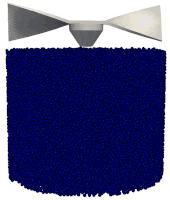

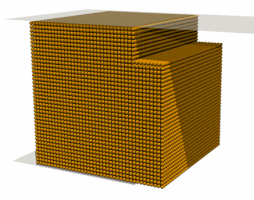
Related publications:
Extraterrestrial Regolith for In Situ Resource Utilization
In-situ resource utilization (ISRU) is a critical component of NASA’s current and future planetary exploration missions, forming the cornerstone of the agency's strategy for creating a sustainable human presence on the Moon and beyond. The overarching goal of our research is to advance our understanding of Lunar and Martian regolith and to develop innovative technologies that enable its use as a resource for constructing infrastructure on the lunar and Martian surface. Our key contributions include:
- Advanced discrete element modeling for predicting the behavior of lunar regolith and its interactions with rovers and engineering systems in relevant lunar environment (Gaines et al. 2024; Badal et al. 2024; Sun et al. 2024).
- Image-based and machine learning-assisted characterization of Lunar and Martian regolith simulants (Lai & Chen 2019; ; Lai & Chen 2017; ).
- Regolith-based functional composites and biocementation of Martian regolith for ISRU (Gleaton et al. 2022; Gleaton et al. 2019; Shukla et al. 2018).


Selected publications:
Image-based Analysis and Machine Learning-enabled Modeling
We integrate novel machine learning and image processing techniques with advanced numerical models to enhance material characterization and predictive modeling. Key contributions include:
- A novel machine learning-enabled discrete element method for irregular-shaped particles (Lai et al. 2022; Lai et al. 2020).
- Reconstructing granular particles from X-ray computed tomography using the machine learning method (Lai & Chen 2019).
- X-ray CT-based porosity analysis and microstructure reconstruction (Sun et al. 2021; Sun et al. 2022).
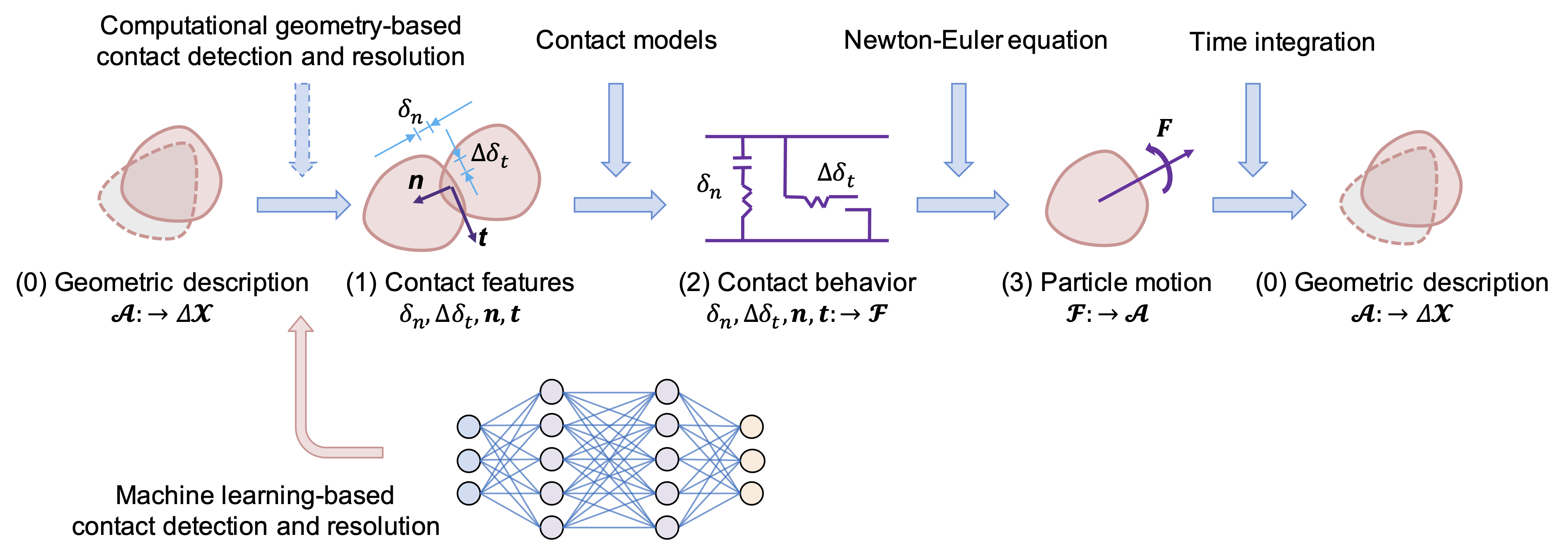


Selected publications:
Multiphysics and Multiscale Problems in Geomechanics
The fully coupled diffusion-deformation process occurring within porous media, such as sand, clay, and rock, is of interest to numerous geotechnical engineering applications. The presence of fluid inside the pores and in between the interconnected grains may induce excess pore pressure, limit volumetric deformation, and introduce rate dependence to the mechanical response of the solid skeleton due to the transient nature of fluid diffusion. Our contributions include a stabilized enhanced strain finite element procedure coupled with an elasto-plastic cap model for porous rocks, multiphysics modeling of geologic carbon dioxide sequestration (GCS), and the hydromechanical response of seabed-pipeline interactions, considering anisotropic heterogeneous seabed properties.
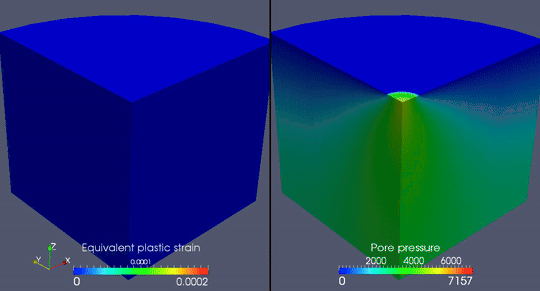

The term granular media embraces a wide variety of materials both in nature and in engineering applications. Examples of granular media include sand, sandstone, pharmaceutical pills, and so on. Because of the abundant appearance, understanding and modeling of failure phenomena in granular materials can be of great practical importance. For instance, the design of a foundation/footing resting on granular soils requires the knowledge of the bearing capacity of the underlying media; sequestration of CO2 into reservoir requires the understanding of deformation band formation in sandstone that serves as flow barrier. Our key contribution is the proposed multiscale approaches for modeling failure of granular media, where material descriptions at continuum scales are enhanced by information from finer scales.
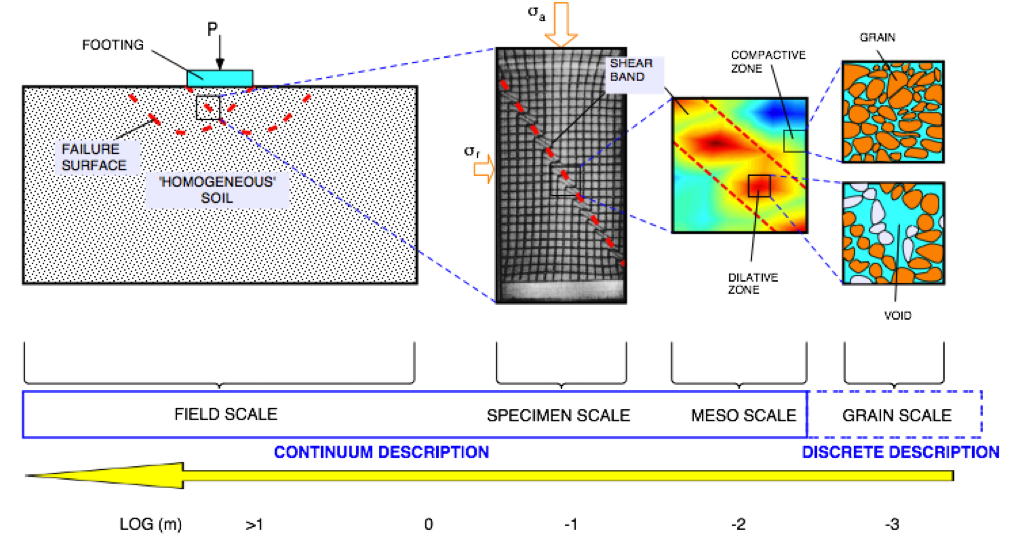

Selected publications:
Software & Code
- LIGGGHTS-INL: An open-source parallel discrete element method particle simulation software.
- Albany: A open-source parallel implicit finite element code.
- Paraview: An open-source multi-platform data analysis and visualization application.
- Altair EDEM: A commercial high-performance software for bulk and granular material simulation.
- ANSYS Rocky: A commercial high-fidelity particle simulation software for complex-shaped particles.
- Trelis: A commercial geometry and mesh generation software for FEA and CFD simulations.
Research Sponsors: We are grateful for the past and present support of our research by the U.S. Department of Energy, U.S. Geological Survey, U.S. Department of Education, NSF, NASA SC Space Grant Consortium, NASA EPSCoR, NASA/BWX, American International Group, Idaho National Laboratory, and Clemson University.
